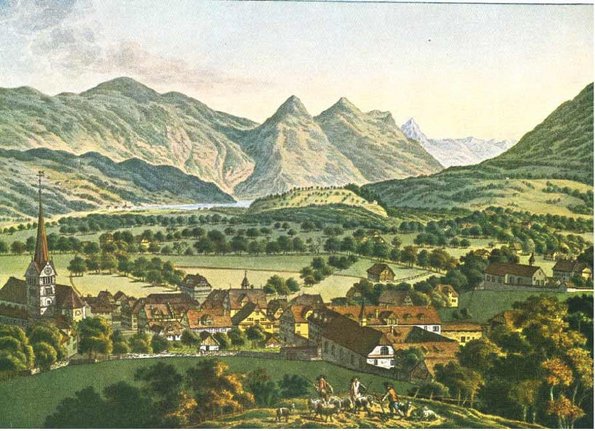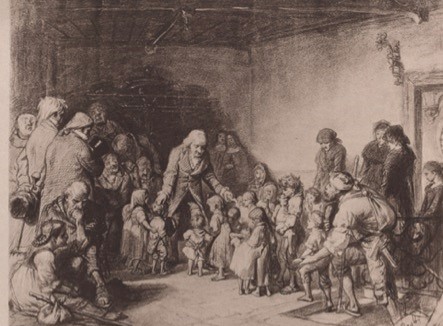“Among ten children, hardly any knew the ABC”
by Carl Bossard
Wars affect children in particular. Currently in Afghanistan. The great suffering is reminiscent of a humanitarian fate in Switzerland. It is connected with Pestalozzi’s brief work in Stans. An attempt to commemorate.
“Many [came] with rags laden with vermin, many gaunt, like emaciated skeletons, with eyes full of fear and foreheads full of wrinkles of worry; [...] others crushed by misery.”1 This is how Johann Heinrich Pestalozzi (1746–1827) describes the arrival of war-disabled children at his orphanage in Stans. It was early December 1798 – the first year of the Helvetic Republic (1798–1803).
The implosion of the Old Confederation
Pestalozzi’s touching description came to mind while reading a correspondent’s report from Afghanistan. The news from the Hindu Kush is stirring: The situation was desolate; million children were starving.2 Particularly shocking: the picture of a malnourished toddler, emaciated and spindly. Pestalozzi must have experienced something similar in the post-war microcosm of Nidwalden.
What had happened? The French Revolution of 1789 seems to many like a tectonic quake, like a volcanic eruption. The revolutionary lava of political upheaval rolled over the entire continent. Napoleon’s armies have an easy time of it, there is little resistance. His troops also occupy Switzerland. The rebellious cry of “Liberté, Egalité, Fraternité” abruptly brings down what had become rotten. In the spring of 1798, the Old Confederation collapses. The Helvetic government is installed in Aarau.
Elevenfold superiority
The new central authority demands the oath of allegiance to the Helvetic Unity Constitution. The people of Nidwalden refuse and reject it. Attempts at mediation fail; ultimatums are not even answered. So, it comes to the threatened military invasion. On 9 September 1798, French units under the command of General Schauenburg conquer and occupy the small Free State – against a heroic but ultimately exhaustingly futile resistance.
1,600 Nidwaldeners fight against a foreign superiority of 17,700 professional soldiers. Around 100 Frenchmen and 100 Nidwaldeners lose their lives in the fierce fighting. Another 300 women, men and children die in acts of revenge by the occupying army. Over 330 houses and around 200 stables go up in flames; almost ten churches and chapels are destroyed.3 A horizon of black burnt ruins! The area is “for the most part burnt and devastated”, reports Schauenburg. Unheard-of suffering as a result of the punitive expedition!
Only an educated people can have a say
The hardship, which is tangible everywhere, affects the children in particular, but not only. Some of the people live in miserable huts, “which protect them against wind and weather to the utmost need”. “The misery [of the population] is indescribably great and it grows with every day”, a government official describes the situation in January 1799. He adds: Cold and frost had destroyed the few potato stocks. In need, people would now eat spoiled tubers, which would make them sick.4
As part of the urgent reconstruction, the Helvetic government is planning an educational and poorhouse for Stans – for children from the age of six. The reconstruction of the education system is one of the central goals of the new state. The development and expansion of schools has top priority. The motto: Only an educated people can make the new republic concrete and have a democratic say.
A confident “I liked to go”
The task is enormously difficult. The search is on for a Catholic, but he cannot be found. So, the choice falls on the Protestant and sympathiser of the Helvetic Republic, Johann Heinrich Pestalozzi. Is he aware of the pitfalls? Hardly. “I liked to go”, he states confidently. On 7 December 1798, he moved into the convent. But he finds a construction site; moreover, the building is “in no way equipped for the purpose of an orphanage [with] a considerable number of children”.
In mid-January 1799, the orphanage is officially opened – with 45 children. There is still rubble and dirt everywhere. “The dust from the walls filled all the corridors”, Pestalozzi writes. This “completed the discomfort of the beginning”. And he adds: “At the start I had to send some of the poor children home for the night because of the lack of beds. These would return verminously the following mornings.”
Extremely difficult literacy
Soon Pestalozzi is looking after more than 80 children; only a maid helps him. The task requires almost Herculean powers. A pedagogical borderline situation! How demanding his mission turns out to be is shown by the fact: “Among ten children, hardly one could read the ABC”, he complains.”5 And he continues: “There was even less talk of other school lessons or essential means of education.”
“The complete lack of school education” of the children does not discourage Pestalozzi. On the contrary! “I was as much as alone in their midst from morning to evening. [...] They were with me and I was with them. Their soup was mine, their drink was mine.” Soon there were visible successes: “Learning was completely new to [the children], and as soon as some of them saw that they could achieve something, their zeal became tireless. Children who had never held a book in their lives [...] came in a few weeks to study with the greatest interest from early in the morning until late in the evening, almost incessantly.”
The abrupt end of Pestalozzi’s dream
A dream comes true for Pestalozzi: to educate the poor in human responsibility, to help the “people in the Zwilch”. The longing of his educational existence is condensed in this. But the dream ends abruptly. Helvetic and French troops needed the rooms as barracks and military hospitals. On 8 June 1799, the government withdrew his assignment. Disappointed, Pestalozzi writes: “Those were my dreams; I had to leave Stans now that I thought I was so close to fulfilling them.” Exhausted, he accepts the invitation of an acquaintance and retreats to the Gurnigelbad for a cure. In a long letter to a friend, he describes and analyses his short time work in Nidwalden. The “Stans Letter” is considered the most concise document on Pestalozzi’s pedagogical attitude and educational thinking. Testimony to his humane energy.
A small postscript: looking back into the oppressive past perhaps makes one grateful for today’s provisions – this in a world that also seems to be coming apart at the seams here and there. •
1 Pestalozzi über seine Anstalt in Stans [kurz: “Stanser Brief” von 1799] (1997). (Pestalozzi on his institution in Stans [in short: “Stans Letter” of 1799] (1997). With an interpretation and new introduction by Wolfgang Klafki. Weinheim and Basel: Beltz Verlag, p. 9; the citations are taken from this publication.
2 Roth, Jonas. “In Afghanistan bahnt sich eine humanitäre Katastrophe an” (A humanitarian catastrophe is brewing in Afghanistan). In: Neue Zürcher Zeitung of 24 December 2021, p. 5
3 cf. Messmer, Kurt. “Nidwalden 1798 – Erinnerung ist machbar” (Nidwalden 1798 – Remembrance is feasible). In: https://blog.nationalmuseum.ch/2020/09/nidwalden-1798-erinnerung-ist-machbar/ [Status: 30 December 2021]
4 Haller-Dir, Marita (2015). “‘Die grösste Herzlichkeit für mein Werk fand ich bey den Kapuzinern und Klosterfrauen’. Johann Heinrich Pestalozzi’s Zeit in Stans vom 7.12.1798 bis 8.6.1799” (I found the greatest cordiality for my work among the Capuchins and the nuns. Johann Heinrich Pestalozzi’s time in Stans from 7 December 1798 to 8 June 1799). In: Der Geschichtsfreund, vol. 168, p. 260f.
5 Bräker, Ulrich. “Lebensgeschichte und natürliche Ebenteuer (sic) des armen Mannes im Tockenburg” (Life story and natural adventures (sic) of the poor man in Tockenburg). In: Bräker’s Werke in einem Band. Berlin and Weimar 1966, pp. 83ff.
Source: https://www.journal21.ch/artikel/unter-zehn-kindern-konnte-kaum-eins-das-abc of 31 December 2021

